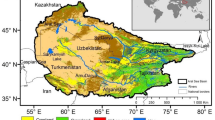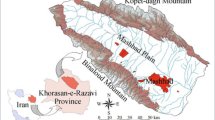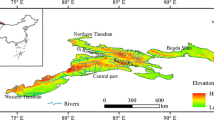Abstract
As one of the most popular vegetation indices to monitor terrestrial vegetation productivity, Normalized Difference Vegetation Index (NDVI) has been widely used to study the plant growth and vegetation productivity around the world, especially the dynamic response of vegetation to climate change in terms of precipitation and temperature. Alberta is the most important agricultural and forestry province and with the best climatic observation systems in Canada. However, few studies pertaining to climate change and vegetation productivity are found. The objectives of this paper therefore were to better understand impacts of climate change on vegetation productivity in Alberta using the NDVI and provide reference for policy makers and stakeholders. We investigated the following: (1) the variations of Alberta’s smoothed NDVI (sNDVI, eliminated noise compared to NDVI) and two climatic variables (precipitation and temperature) using non-parametric Mann-Kendall monotonic test and Thiel-Sen’s slope; (2) the relationships between sNDVI and climatic variables, and the potential predictability of sNDVI using climatic variables as predictors based on two predicted models; and (3) the use of a linear regression model and an artificial neural network calibrated by the genetic algorithm (ANN-GA) to estimate Alberta’s sNDVI using precipitation and temperature as predictors. The results showed that (1) the monthly sNDVI has increased during the past 30 years and a lengthened growing season was detected; (2) vegetation productivity in northern Alberta was mainly temperature driven and the vegetation in southern Alberta was predominantly precipitation driven for the period of 1982–2011; and (3) better performances of the sNDVI-climate relationships were obtained by nonlinear model (ANN-GA) than using linear (regression) model. Similar results detected in both monthly and summer sNDVI prediction using climatic variables as predictors revealed the applicability of two models for different period of year ecologists might focus on.









Similar content being viewed by others
References
Albergel C, Brocca L, Wagner W, De Rosnay P, et al. (2013) Chapter 18: selection of performance metrics for global soil moisture products: the case of ASCAT product. In: GP Petropoulos (Ed.), Remote sensing of land surface turbulent fluxes and soil surface moisture content: state of the art. Taylor & Francis (p. 562)
Barichivich J, Briffa KR, Myneni R et al (2014) Temperature and snow-mediated moisture controls of summer photosynthetic activity in northern terrestrial ecosystems between 1982 and 2011. Remote Sens 6:1390–1431
Bayazit M, Önöz B (2007) To prewhiten or not to prewhiten in trend analysis? Hydrol Sci J 52:611–624
Canon J, Dominguez F, Valdes JB (2011) Vegetation responses to precipitation and temperature: a spatiotemporal analysis of ecoregions in the Colorado River Basin. Int J Remote Sens 32:5665–5687
Chuai XW, Huang XJ, Wang WJ, Bao G (2012) NDVI, temperature and precipitation changes and their relationships with different vegetation types during 1998–2007 in Inner Mongolia, China. Int J Climatol 33:1696–1706
de Jong R, de Bruin S, de Wit A, Schaepman ME, Dent DL (2011) Analysis of monotonic greening and browning trends from global NDVI time-series. Remote Sens Environ 115:692–702
Dorigo WA, Zurita-Milla R, de Wit AJW et al (2007) A review on reflective remote sensing and data assimilation techniques for enhanced agroecosystem modeling. Int J Appl Earth Obs Geoinf 9:165–193
Dorigo W, De Jeu R, Chung D et al (2012) Evaluating global trends (1988–2010) in homogenized remotely sensed surface soil moisture. Geophys Res Lett 39:L18405
Gan TY (1998) Hydroclimatic trends and possible climatic warming in the Canadian Prairies. Water Resour Res 34:3009–3015
Gómez-Mendoza L, Galicia L, Cuevas-Fernández ML et al (2008) Assessing onset and length of greening period in six vegetation types in Oaxaca, Mexico, using NDVI-precipitation relationships. Int J Biometeorol 52:511–520
Gong DY, Shi PJ (2003) Northern hemispheric NDVI variations associated with large-scale climate indices in spring. Int J Remote Sens 24:2559–2566
Gordon S, Wiebe H, Jacksteit R, Bennett S (2005) Water resources management and the energy industry in Alberta, Canada. J Can Pet Technol 44:22–27
Hopkinson RF, Hutchinson MF, McKenney DW, Milewska EJ, Papadopol P (2012) Optimizing input data for gridding climate normals for Canada. J Appl Meteorol Climatol 51:1508–1518
Ichii K, Kawabata A, Yamaguchi Y (2002) Global correlation analysis for NDVI and climatic variables and NDVI trends: 1982–1990. Int J Remote Sens 23:3873–3878
IPCC (2013) Climate change 2013: the physical science basis. Contribution of working group I to the fifth assessment report of the intergovernmental panel on climate change, 2013
Jahan N, Gan TY (2011) Modelling the vegetation-climate relationship in a boreal mixedwood forest of Alberta using normalized difference and enhanced vegetation indices. Int J Remote Sens 32:313–335
Jiang R, Gan TY, Xie J, Wang N (2014) Spatiotemporal variability of Alberta’s seasonal precipitation, their teleconnection with large-scale climate anomalies and sea surface temperature. Int J Climatol 34:2899–2917
Jiang R, Gan TY, Xie J, Wang N, Kuo CC (2015) Historical and potential changes of precipitation and temperature of Alberta subjected to climate change impact: 1900–2100. Theor Appl Climatol, 1-15, doi: 10.1007/s00704-015-1664-y
Kawabata A, Ichii K, Yamaguchi Y (2001) Global monitoring of interannual changes in vegetation activities using NDVI and its relationships to temperature and precipitation. Int J Remote Sens 22:1377–1382
Kogan F, Guo W, Jelenak A (2011) Global vegetation health: long-term data records. Use of satellite and in-situ data to improve sustainability. Springer, pp. 247–255
Kogan F, Adamenko T, Guo W (2013) Global and regional drought dynamics in the climate warming era. Remote Sens Lett 4:364–372
Kuo CC, Gan TY, Yu PS (2010) Wavelet analysis on the variability, teleconnectivity, and predictability of the seasonal rainfall of Taiwan. Mon Weather Rev 138:162–175
Latifovic R, Trishchenko AP, Chen J, Park WB, Khlopenkov KV, Fernandes R, Pouliot D, Ungureanu C, Luo Y, Wang S, Davidson A, Cihlar J (2005) Generating historical AVHRR 1 km baseline satellite data records over Canada suitable for climate change studies. Can J Remote Sens 31:324–346
Mao D, Wang Z, Luo L, Ren C (2012) Integrating AVHRR and MODIS data to monitor NDVI changes and their relationships with climatic parameters in Northeast China. Int J Appl Earth Obs 18:528–536
Mekis E, Vincent LA (2011) An overview of the second generation adjusted daily precipitation dataset for trend analysis in Canada. Atmosphere-Ocean 49:163–177
Mwale D, Gan TY (2005) Wavelet analysis of variability, teleconnectivity, and predictability of the September-November East African rainfall. J Appl Meteorol 44:256–269
Mwale D, Gan TY, Shen SSP (2004) A new analysis of variability and predictability of seasonal rainfall of central southern Africa for 1950–94. Int J Climatol 24:1509–1530
Mwale D, Gan TY, Shen SSP, Shu TT, Kim KM (2007) Wavelet empirical orthogonal functions of space-time-frequency regimes and predictability of southern Africa summer rainfall. J Hydrol Eng 12:513–523
Mwale D, Gan TY, Devito K, Mendoza C, Silins U, Petrone R (2009) Precipitation variability and its relationship to hydrologic variability in Alberta. Hydrol Process 23:3040–3056
Neigh CSR, Tucker CJ, Townshend JRG (2007) Synchronous NDVI and surface air temperature trends in Newfoundland: 1982 to 2003. Int J Remote Sens 28:2581–2598
Nemani RR, Keeling CD, Hashimoto H et al (2003) Climate-driven increases in global terrestrial net primary production from 1982 to 1999. Science 300:1560–1563
Piao S, Fang J, Zhou L, Guo Q, Henderson M, Ji W, Li Y, Tao S (2003) Interannual variations of monthly and seasonal normalized difference vegetation index (NDVI) in China from 1982 to 1999. J Geophys Res 108:4401
Piao SL, Ciais P, Huang Y, Shen ZH, Peng SS, Li JS, Zhou LP, Liu HY, Ma YC, Ding YH, Friedlingstein P, Liu CZ, Tan K, Yu YQ, Zhang TY, Fang JY (2010) The impacts of climate change on water resources and agriculture in China. Nature 467:43–51
Pouliot D, Latifovic R, Olthof I (2009) Trends in vegetation NDVI from 1 km AVHRR data over Canada for the period 1985–2006. Int J Remote Sens 30:149–168
Prasad VK, Anuradha E, Badarinath KVS (2005) Climatic controls of vegetation vigor in four contrasting forest types of India—evaluation from National Oceanic and Atmospheric Administration’s Advanced Very High Resolution Radiometer datasets (1990–2000). Int J Biometeorol 50:6–16
Tanzeeba S, Gan TY (2012) Potential impact of climate change on the water availability of South Saskatchewan River Basin. Clim Chang 112:355–386
Vincent LA, Gullett DW (1999) Canadian historical and homogeneous temperature datasets for climate change analyses. Int J Climatol 19:1375–1388
Vincent LA, Wang XLL, Milewska EJ, Wan H, Yang F, Swail V (2012) A second generation of homogenized Canadian monthly surface air temperature for climate trend analysis. J Geophys Res-Atmos 117
Wang J, Rich PM, Price KP (2003) Temporal responses of NDVI to precipitation and temperature in the central Great Plains, USA. Int J Remote Sens 24:2345–2364
Yue S, Pilon P, Phinney B, Cavadias G (2002) The influence of autocorrelation on the ability to detect trend in hydrological series. Hydrol Process 16:1807–1829
Zhang XB, Vincent LA, Hogg WD, Niitsoo A (2000) Temperature and precipitation trends in Canada during the 20th century. Atmosphere-Ocean 38:395–429
Zhang XB, Zwiers FW, Hegerl GC, Lambert FH, Gillett NP, Solomon S, Stott PA, Nozawa T (2007) Detection of human influence on twentieth-century precipitation trends. Nature 448:461–U464
Zhou LM, Tucker CJ, Kaufmann RK, Slayback D, Shabanov NV, Myneni RB (2001) Variations in northern vegetation activity inferred from satellite data of vegetation index during 1981 to 1999. J Geophys Res-Atmos 106:20069–20083
Acknowledgments
The study was partly supported by the National Natural Science Foundation of China (Grant Nos. 51509201,41501231,51479160,41471451), Scientific Research Program Funded by Shaanxi Provincial Education Department (Grant No. 15JK1503), Research Foundation of State Key Laboratory Base of Eco-hydraulic Engineering in Arid Area (Grant No. 2013ZZKT-5), and Dr. Start-up Foundation of Xi’an University of Technology (Grant No. 118-211413). CANGRD data sets were provided by Ewa Milewska at the Climate Research Branch of the Meteorological Service of Canada. The weekly smoothed NDVI data is available at the NOAA’s Satellite and Information Service (NRSDIS) (http://www.star.nesdis.noaa.gov/star/index.php). The authors thank Profs. Thian Yew Gan, Felix Kogan, and Dr. Xuezhi Tan for their assistance on this study. The valuable comments and suggestions of Prof. Scott C. Sheridan and two anonymous reviewers have greatly improved our manuscript.
Author information
Authors and Affiliations
Corresponding authors
Rights and permissions
About this article
Cite this article
Jiang, R., Xie, J., He, H. et al. Spatiotemporal variability and predictability of Normalized Difference Vegetation Index (NDVI) in Alberta, Canada. Int J Biometeorol 60, 1389–1403 (2016). https://doi.org/10.1007/s00484-015-1132-5
Received:
Revised:
Accepted:
Published:
Issue Date:
DOI: https://doi.org/10.1007/s00484-015-1132-5




